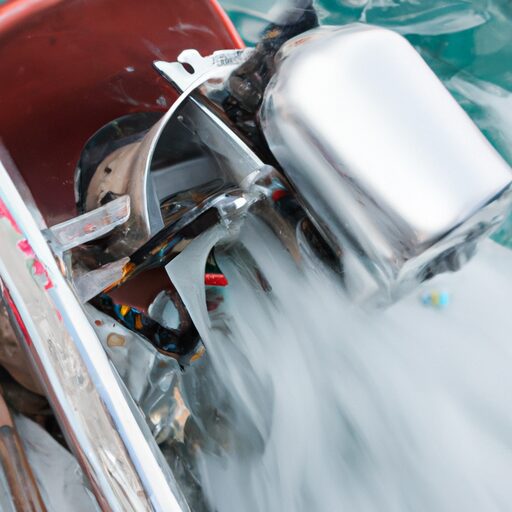Checking Hydraulic Fluid On Tractor
The efficient operation of a tractor’s hydraulic system is crucial for its overall performance and productivity. Regularly checking the hydraulic fluid levels is an essential maintenance task that ensures optimal functioning and prevents potential damage to the system. This article provides detailed instructions on how to check the hydraulic fluid on a tractor, addressing the necessary tools and equipment required for the task. It also outlines the steps involved in locating the hydraulic fluid reservoir, assessing the fluid level and condition, and adding or changing it if necessary. Additionally, this article emphasizes inspecting for leaks or damage as part of proper hydraulic fluid maintenance. By following these guidelines, tractor owners can maintain their machines’ hydraulic systems effectively and prolong their lifespan. The technical nature of this article aims to provide a comprehensive understanding of checking hydraulic fluid on tractors to an audience seeking insightful information on this topic.
Importance of Regularly Checking Hydraulic Fluid Levels
Regularly monitoring hydraulic fluid levels is of utmost importance in maintaining the optimal performance and longevity of a tractor’s hydraulic system. Hydraulic fluid serves as a vital component in facilitating the transfer of power within the system, and its proper maintenance is crucial to prevent potential damage or malfunction. One key aspect that should be monitored is the hydraulic fluid temperature. This parameter provides valuable information about the overall health of the system, as excessively high temperatures can indicate issues such as excessive friction or insufficient cooling. By regularly checking and maintaining appropriate temperatures, operators can ensure that their tractors operate efficiently and avoid costly repairs.
Another important reason to monitor hydraulic fluid levels is to identify common symptoms associated with low fluid levels. These symptoms include increased noise during operation, sluggish response from hydraulic components, unresponsive controls, and leaks around fittings or seals. Neglecting these warning signs can lead to severe consequences such as reduced productivity or even complete system failure.
To gather the necessary tools and equipment for checking hydraulic fluid levels, operators must ensure they have an appropriate dipstick or sight glass specific to their tractor’s make and model. Additionally, it may be necessary to have a clean cloth or paper towel on hand for wiping away any dirt or debris before inspecting the fluid level.
Gather the Necessary Tools and Equipment
Essential for the task at hand, it is imperative to ensure that all necessary tools and equipment are readily available before proceeding. To successfully check the hydraulic fluid on a tractor, gather the following items:
- Clean cloth or rag: This will be used to wipe any excess fluid off the dipstick and clean any dirt or debris from the reservoir cap.
- Safety goggles: It is crucial to protect your eyes from potential splashes or spills of hydraulic fluid.
- Gloves: Wearing gloves will not only keep your hands clean but also protect them from any harmful chemicals present in the fluid.
Proper disposal of hydraulic fluid is of utmost importance. Contaminated hydraulic fluid can lead to system failures and costly repairs. Signs of contaminated hydraulic fluid include a milky color, foaming, unusual odor, or particles floating in the fluid. If any of these signs are observed, it is essential to dispose of the old fluid responsibly and replace it with fresh, uncontaminated fluid.
Having gathered all necessary tools and being aware of proper disposal procedures as well as signs of contamination, we can now move on to locating the hydraulic fluid reservoir.
Locate the Hydraulic Fluid Reservoir
To proceed with the task at hand, it is crucial to first locate the reservoir that contains the hydraulic fluid. The hydraulic fluid reservoir is where the tractor stores its hydraulic oil. It is essential to know its location in order to properly check and maintain the hydraulic system. Typically, the reservoir can be found near or on top of the engine or transmission.
| Reservoir Location |
|---|
| Near engine |
| On top of engine |
| Near transmission |
Checking hydraulic fluid on a tractor involves several steps, and locating the reservoir is just the beginning. Once you have located it, you can move on to checking the fluid level and condition. This step allows you to assess whether there is enough fluid in the system and if it needs to be replaced or topped up. By regularly inspecting and maintaining your tractor’s hydraulic fluid, you can ensure optimal performance and prevent potential issues that may arise from low or contaminated fluid levels.
Check the Fluid Level and Condition
After locating the hydraulic fluid reservoir, the next step is to assess the level and condition of the fluid. Proper maintenance of hydraulic fluid is crucial for optimal tractor performance and longevity. Checking the fluid level ensures that there is enough fluid to operate the system effectively. Low levels can lead to inadequate lubrication, resulting in increased friction and wear on key components. On the other hand, overfilling can cause excessive pressure within the system, leading to leaks or damage.
In addition to checking the level, it is essential to examine the condition of the hydraulic fluid. Signs of contaminated hydraulic fluid include a milky appearance, an unpleasant odor, or debris floating in it. Contamination can occur due to water infiltration, dirt ingress, or degradation of additives over time. Contaminated hydraulic fluid reduces its ability to lubricate and protect components properly.
Regularly monitoring and maintaining proper hydraulic fluid levels and quality are vital for ensuring optimal tractor performance and extending its lifespan. If necessary, adding or changing the hydraulic fluid will be discussed in detail in subsequent sections.
Transitioning into adding or changing the hydraulic fluid if necessary…
Add or Change the Hydraulic Fluid if Necessary
One crucial step in maintaining optimal performance and longevity of the hydraulic system involves monitoring and, if necessary, adding or changing the hydraulic fluid. Hydraulic fluid is a vital component in ensuring smooth operation of tractors and other machinery that rely on hydraulics for power transmission. Over time, the fluid may become contaminated with dirt, moisture, or other impurities that can compromise its effectiveness. Additionally, wear and tear can cause the fluid to degrade and lose its lubricating properties.
To add or change hydraulic fluid, it is important to first consult the manufacturer’s instructions or specifications for the tractor model being used. This will ensure that the correct type and quantity of hydraulic fluid are added. It is also essential to use clean containers and equipment during this process to prevent contamination.
When adding new hydraulic fluid, it is recommended to drain out any existing fluid before refilling the reservoirs. This helps in removing any contaminants present in the old fluid. After adding new fluid, it is necessary to check for proper level using dipsticks or sight gauges provided by manufacturers.
In conclusion, regularly checking and maintaining hydraulic fluids by adding or changing them when necessary ensures optimal performance of tractors. By doing so, potential damage caused by contaminated or degraded fluids can be prevented effectively. Moving forward into inspecting for leaks or damage requires an understanding of these essential steps for maintaining a properly functioning hydraulic system without compromising its efficiency.
Inspect for Leaks or Damage
Inspecting for leaks or damage is an essential step in maintaining the hydraulic system of a tractor. Hydraulic hoses play a crucial role in the proper functioning of this system, as they transport the hydraulic fluid throughout different components. Therefore, it is important to regularly inspect these hoses for any signs of wear and tear. Common problems that can occur with hydraulic hoses include leaks, cracks, bulges, or abrasions. Leaks can result from loose fittings or damaged seals, while cracks and bulges may be caused by excessive pressure or age. Additionally, abrasive damage can occur due to friction against other components or external objects.
To identify such issues, a thorough visual inspection should be conducted on all hydraulic hoses. It is important to look for any visible signs of leakage or damage along the entire length of each hose. Special attention should be given to areas where hoses bend or come into contact with sharp edges. Any identified problem should be addressed immediately to prevent further damage and ensure optimal performance of the hydraulic system.
By inspecting hydraulic hoses regularly and addressing any issues promptly, tractor owners can avoid costly repairs and downtime associated with failure of these critical components. Moving forward, let us explore some tips for properly maintaining hydraulic fluid in tractors without compromising its functionality and longevity.
Tips for Proper Hydraulic Fluid Maintenance
To effectively maintain the proper functionality and longevity of hydraulic systems, it is essential to adhere to specific guidelines for the regular upkeep of the hydraulic fluid. Common hydraulic fluid problems can arise if proper maintenance procedures are not followed. One common issue is contamination of the hydraulic fluid, which can negatively impact system performance and lead to costly repairs.
Signs of contaminated hydraulic fluid include a decrease in system efficiency, increased noise during operation, and erratic or jerky movements. Additionally, visual inspection may reveal discolored or cloudy fluid, as well as the presence of particles or debris. If any of these symptoms are observed, immediate action should be taken to address the issue.
Regularly monitoring and testing the quality of the hydraulic fluid is crucial for preventing contamination. This can be done by conducting routine oil analysis to identify any potential contaminants such as water, dirt, or metal particles. Additionally, maintaining cleanliness in the surrounding environment is important in preventing foreign substances from entering the system.
In conclusion, proper maintenance of hydraulic fluid is vital for ensuring optimal performance and prolonging the lifespan of hydraulic systems. By being aware of common issues and regularly inspecting for signs of contamination, operators can take proactive measures to prevent problems before they escalate into more significant failures.
Frequently Asked Questions
How often should I check the hydraulic fluid levels on my tractor?
On average, hydraulic fluid in a tractor should be checked every 100 hours of operation. Neglecting to do so can result in decreased performance and potential damage to the hydraulic system, leading to costly repairs.
Can I use any type of hydraulic fluid for my tractor?
Hydraulic fluid properties and compatibility with different tractor models vary. It is important to consult the tractor’s manual or the manufacturer to determine the appropriate type of hydraulic fluid for optimal performance and to avoid potential damage.
Is it necessary to warm up the tractor before checking the hydraulic fluid levels?
Warming up a tractor before checking hydraulic fluid levels is not necessary. However, it is crucial to maintain proper fluid levels to ensure the efficient operation of the hydraulic system, preventing damage and maintaining optimal performance.
Are there any specific safety precautions I should take while checking the hydraulic fluid?
Safety precautions when checking hydraulic fluid include wearing appropriate safety gear such as gloves and safety glasses. Follow the proper procedure by ensuring the tractor is turned off, relieving pressure in the system, and using a clean cloth to check fluid levels.
What are the common signs that indicate a hydraulic fluid leak in a tractor?
Common signs of a hydraulic fluid leak in a tractor include puddles or drips of fluid under the machine, reduced or erratic performance, unusual noises or vibrations, and a decrease in fluid level. Repairing a hydraulic fluid leak involves identifying the source, replacing faulty components, and ensuring proper sealing.
Conclusion
Regularly checking the hydraulic fluid levels on a tractor is crucial for maintaining its performance and preventing damage. By gathering the necessary tools and equipment, locating the hydraulic fluid reservoir, and checking the fluid level and condition, you can ensure that your tractor operates smoothly. If needed, adding or changing the hydraulic fluid is essential to maintain optimal functioning. Additionally, inspecting for leaks or damage ensures early detection of potential issues. Just as a well-oiled machine runs smoothly, regularly checking hydraulic fluid levels keeps your tractor in top shape.






